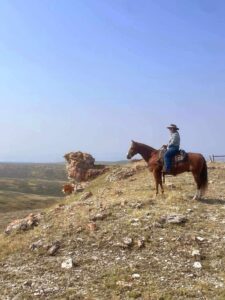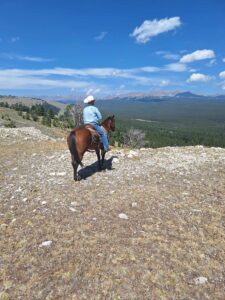Riding Through the Last Week
#bfrdpwy #aginternship #RightRisk

My final week has been one to conclude a fantastic summer. This week included more chopping of Larkspur, checking and doctoring calves, and moving yearling heifers to a new pasture. Since I discussed the effects of Larkspur last week, I wanted to talk about the differences between moving yearlings and pairs. Yearlings are young, spry and full of life while the older cows have been there, done that a few times over. When we move pairs, it’s important to make sure the cows are paired with their calf or they don’t like to move well, whereas yearlings will see you coming from 20 yards away and head for the hills. The yearlings get very excited and like to run, so it is important not to put as much pressure on them as the older cows sometimes need.
While checking calves with my host, we found one calf that needed some medicine. I noticed him walking around and he looked, what I like to call, “dopey”. He didn’t really notice when I walked my horse up close to him when he should’ve wanted to run away. He also didn’t care to keep up with his mama when she moved away, so I knew he didn’t feel good. I notified my host who proceeded to catch the calf. With just my host and I, he tied his rope to his horn and got off his horse to administer the medicine while I was holding the calf down. After letting the calf free, my host wanted to show me how to “tie one off” (aka, tie your rope to the horn of the saddle so the horse will hold the rope tight while the calf gets doctored). I learned that to tie off properly, one half hitch knot is used around the horn; however, the reins of the horse must be tied over the rope slightly tight to make sure the horse goes backwards if he gets frightened. This is important because if the horse turns away from the calf, he could get his legs caught in the rope, causing a wreck, or he could turn tail and run, which would most likely kill the calf. In the event of a mishap, the most important thing to do is untie the knot from the horn. If that is not an option, then cutting the rope is essential for everyone’s safety.

I had a multitude of great conversations of questions I would come up with while riding the pastures with my host and he would answer them to the best of his knowledge. One question that I would like to investigate farther was, why did my host conduct a pap test on his yearling heifers. A pap test is conducted by a veterinarian and can diagnose heart disease. Heart disease is a problem that my host has had issues with before and it causes what is known as “brisket disease”. Brisket disease and heart disease are mainly the same thing, it just became known as “brisket” disease because the brisket of the cow would swell when she was affected. It is a risk of having cattle at higher elevations, as it is harder for the heart to pump enough blood and oxygen to the cow’s body at higher elevations. The pap test my host will have done on his heifers will tell him if the young cow has any issue with it, which could cause her to develop brisket disease. I want to know if this is a test that is necessary for producers across the country, or mainly the mountainous areas. My host has mentioned there are a few producers around their area who also do pap tests on their cows as a precaution for brisket disease.
I have appreciated all the time my entire host family has taken to teach me about a multitude of areas, all connecting back to cows. I plan to use the knowledge I have acquired to finish my degree in rangeland management and pursue a career in the range field, hoping I can assist ranchers in the future to keep their livelihoods healthy and happy.
Submitted by: Ronnie Owens
Edits by: GrowinG Internship Team

